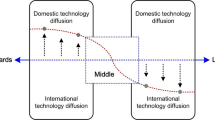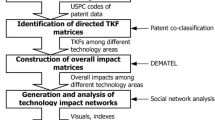Abstract
This study investigates technology convergence of AI considering both industrial sectors and technological characteristics with patent data in terms of two-way approaches: IPC-based network analyses and text-based clustering analysis. The IPC-based network analyses, which indicate a top-down approach in this study, focuses on influential technology area with hub nodes and their tie nodes in an IPC-based convergence network. A network centrality analysis is applied to determine the hub nodes which identify notable industrial sectors and influential technology. In addition, an ego-network analysis is conducted to examine the strongly related technology on the hub nodes. Meanwhile, from a bottom-up approach, a text-based clustering analysis is performed and the result shows an applied target of the technology and an integrated form of various technology which are not found from the top-down approach. Consequently, this study suggests new research framework to understand technology convergence based on the industrial sector, influential technology category, and technology application aspects. In line with the findings, this study analyzes technology convergence of AI by the notable industrial sectors: finance/management, medical, transport, semiconductor, game, and biotechnology sector. The results of this study suggest practical implications for AI technology and related industries.





Similar content being viewed by others
Data availability
USPTO patent data from Google Patent Datasets.
Code availability
UCINET, Python custom code.
References
Athereye, S., & Keeble, D. (2000). Technological convergence, globalization and ownership in the UK computer industry. Technovation, 20, 227–245.
Baek, S., Kim, K., & Altmann, J. (2014). Role of platform provider in service network evolution: the case of Salesforce.com AppExchange. In 2014 IEEE conference on business informatics, Geneva, Switzerland, Jul. 39–45.
Bishop, C. M. (2006). Pattern recognition and machine learning. Springer.
Borgatti, S. P., Everett, M. G., & Freeman, L. C. (2002). Ucinet 6 for windows: software for social network analysis. Analytic Technologies.
Borgatti, S. P., Everett, M. G., & Johnson, J. C. (2013). Analyzing social networks. SAGE Publications.
Brynjolfsson, E. Rock, D., & Syverson, C. (2017). Artificial intelligence and the modern productivity paradox: a clash of expectations and statistics. National Bureau of Economic Research. NBER Working Paper No. 24001. http://www.nber.org/papers/w24001
Burnham, K. P., & Anderson, D. R. (2002). Model selection and multi-model inference: a practical information-theoretic approach. Springer-Verlag.
Choi, J. Y., Jeong, S., & Kim, K. (2015). A Study on diffusion pattern of technology convergence: patent analysis for Korea. Sustainability, 7, 11546–11569.
Curran, C. S., & Leker, J. (2011). Patent indicators for monitoring convergence - examples from NFF and ICT. Technological Forecasting and Social Change, 78(2), 256–273.
Deloitte. (2016). The expansion of Robo-advisory in wealth management. 8/2016, 1–5.
Deloitte. (2018). State of AI in the Enterprise. 2nd Edition, 1–25.
Freeman, L. C. (1979). Centrality in social networks conceptual classification. Social Networks., 1(3), 215–239.
Fujii, H., & Managi, S. (2018). Trends and priority shifts in artificial intelligence technology invention: a global patent analysis. Economic Analysis and Policy, 58, 60–69.
Hagedoorn, J., & Cloodt, M. (2003). Measuring innovative performance: is there an advantage in using multiple indicators? Research Policy, 32(8), 1365–1378.
Han, E. J., & Sohn, S. Y. (2016). Technological convergence in standards for information and communication technologies. Technological Forecasting and Social Change, 106, 1–10.
Harhoff, D., Narin, F., Scherer, F. M., & Vopel, K. (1999). Citation frequency and the value of patented inventions. Review of Economics & Statistics, 81, 511–515.
Houlton, S. (2018). How artificial intelligence is transforming healthcare. The Prescriber, 29(10), 13–17.
Huang, J. (2017). An analysis of the intellectual structure of the cloud patents of SaaS. Technology Analysis and Strategic Management, 29(8), 917–931.
IDC. (2020). Worldwide Artificial Intelligence Software Forecast. 2020–2024, Aug.
Jackson, M. O. (2008). Social and economic networks. Princeton University Press.
Kim, J., & Lee, S. (2017). Forecasting and identifying multi-technology convergence based on patent data: the case of IT and BT industries in 2020. Scientometrics, 111, 47–65.
Kim, E., Cho, Y., & Kim, W. (2014). Dynamic patterns of technological convergence in printed electronics techniques: patent citation network. Scientometrics, 98, 975–998.
KIPO. (2018). https://www.kipo.go.kr/kpo/HtmlApp?c=33001&catmenu=m06_07_06
Kose, T., & Sakata, I. (2019). Identifying technology convergence in the field of robotics research. Technological Forecasting & Social Change, 146, 751–766.
Kwon, O., An, Y., Kim, M., & Lee, C. (2020). Anticipating technology-driven industry convergence: evidence from large-scale patent analysis. Technology Analysis and Strategic Management, 32(4), 363–378.
Lee, D. H., Seo, I. W., Choe, H. C., & Kim, H. D. (2012). Collaboration network patterns and research performance: the case of Korean public research institutions. Scientometrics, 91, 925–942.
Lee, S., Kim, W., Lee, H., & Jeon, J. (2016). Identifying the structure of knowledge networks in the US mobile ecosystem: patent citation analysis. Technology Analysis and Strategic Management, 28(4), 411–434.
Liu, J., Chang, H., Forrest, J. Y., & Yang, B. (2020). Influence of artificial intelligence on technological innovation: evidence from the panel data of china’s manufacturing sectors. Technological Forecasting & Social Change., 158, 120142.
Liu, L., Yang, K., Fujii, H., & Liu, J. (2021). Artificial intelligence and energy intensity in China’s industrial sector: effect and transmission channel. Econometric Analysis and Policy, 70, 276–293.
McKinsey & Company. (2018a). Artificial intelligence-automative’s new value-creating engine. January, 1–32.
McKinsey & Company. (2018b). Notes from the AI Frontier insights from hundreds of use cases. April, 1–36.
Nystrom, A. (2008). Understanding change processes in business networks: a study of convergence in Finnish telecommunications 1985–2005. Ph.D. Dissertation. Åbo Akademi University Press. Finland.
Patel, E., & Kushwaha, D. S. (2020). Clustering cloud workloads: K-means vs Gaussian mixture model. Procedia Computer Science, 171, 158–167.
PWC. (2018). The macroeconomic impact of artificial intelligence. February, 1–78.
Rosenberg, N. (1976). Perspectives on Technology. Cambridge University Press.
Schmoch, U. (2008). Concept of a technology classification for Country comparison. WIPO. June 1–15.
Tractica (2016). Top 15 use cases for artificial intelligence, practical AI use cases for big data, vision, and language applications: strategic analysis and market outlook. pp.1–23.
Trajtenberg, M. (1990). A penny for your quotes: patent citations and the value of innovations. Rand Journal of Economics, 21(1), 172–187.
Tseng, C., & Ting, P. (2013). Patent analysis for technology development of artificial intelligence: a country-level comparative study. Innovation: Management, Policy and Practice, 15(4), 463–475.
Wang, Z., Cunha, C. D., Ritou, M., & Furet, B. (2019a). Comparion of K-means and GMM methods for contextual clustering in HSM. Procedia Manufacturing, 28, 154–159.
Wang, Z., Porter, A. L., Wang, X., & Carley, S. (2019b). An approach to identify emergent topics of technological convergence: A case study for 3D printing. Technological Forecasting and Social Change, 146, 723–732.
Wartburg, I., Teichert, T., & Rost. K. (2005). Inventive progress measured by multi-stage patent citation analysis. Research Policy, 34, 1591–1607.
WIPO. (2019a). WIPO Technology Trends 2019: Artificial Intelligence, pp. 1–154.
WIPO. (2019b). https://www.wipo.int/classifications/ipc/ipcpub/?notion=scheme&version=20190101
Yang, J., Ying, L., & Gao, M. (2020). The influence of intelligent manufacturing on financial performance and innovation performance: the case of China. Enterprise Information Systems., 14(6), 812–832.
Yu, K. H., Beam, A. L., & Kohane, I. S. (2018). Artificial intelligence in healthcare. Nature Biomedical Engineering, 2, 719–731.
Funding
Not applicable.
Author information
Authors and Affiliations
Corresponding author
Ethics declarations
Conflicts of interest
The authors declare that they have no conflict of interest.
Rights and permissions
About this article
Cite this article
Lee, S., Hwang, J. & Cho, E. Comparing technology convergence of artificial intelligence on the industrial sectors: two-way approaches on network analysis and clustering analysis. Scientometrics 127, 407–452 (2022). https://doi.org/10.1007/s11192-021-04170-z
Received:
Accepted:
Published:
Issue Date:
DOI: https://doi.org/10.1007/s11192-021-04170-z




